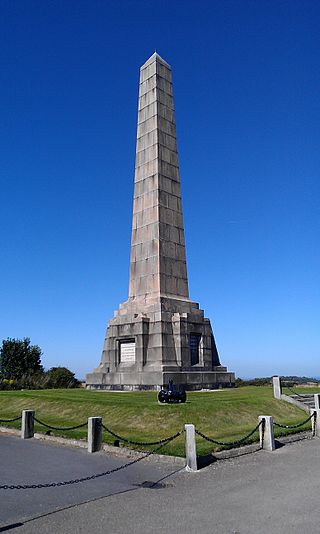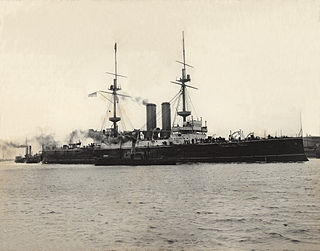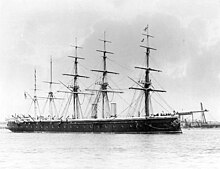
The Home Fleet was a fleet of the Royal Navy that operated from the United Kingdom's territorial waters from 1902 with intervals until 1967. In 1967, it was merged with the Mediterranean Fleet creating the new Western Fleet.

The British Mediterranean Fleet, also known as the Mediterranean Station, was a formation of the Royal Navy. The Fleet was one of the most prestigious commands in the navy for the majority of its history, defending the vital sea link between the United Kingdom and the majority of the British Empire in the Eastern Hemisphere. The first Commander-in-Chief for the Mediterranean Fleet was the appointment of General at Sea Robert Blake in September 1654. The Fleet was in existence until 1967.

The Atlantic Fleet was a naval fleet of the Royal Navy. It existed for two separate periods; 1909 until 1914, and then 1919 until 1932.

The Fourth Sea Lord and Chief of Naval Supplies originally known as the Fourth Naval Lord was formerly one of the Naval Lords and members of the Board of Admiralty which controlled the Royal Navy of the United Kingdom the post is currently known as Chief of Materiel (Fleet). As of 2017, it is also known as Chief of Fleet Support, Chief of Materiel (Ships) then as of 2020, Director General Ships.
The 1st Battle Squadron was a naval squadron of the British Royal Navy consisting of battleships. The 1st Battle Squadron was initially part of the Royal Navy's Grand Fleet. After World War I the Grand Fleet was reverted to its original name, the Atlantic Fleet. The squadron changed composition often as ships were damaged, retired or transferred.

The Dover Patrol and later known as the Dover Patrol Force was a Royal Navy command of the First World War, notable for its involvement in the Zeebrugge Raid on 22 April 1918. The Dover Patrol formed a discrete unit of the Royal Navy based at Dover and Dunkirk for the duration of the First World War. Its primary task was to prevent enemy German shipping—chiefly submarines—from entering the English Channel en route to the Atlantic Ocean, thereby obliging the Imperial German Navy to travel via the much longer route around Scotland which was itself covered by the Northern Patrol.

The 2nd Battle Squadron was a naval squadron of the British Royal Navy consisting of battleships. The 2nd Battle Squadron was initially part of the Royal Navy's Grand Fleet. After World War I the Grand Fleet was reverted to its original name, the Atlantic Fleet. The squadron changed composition often as ships were damaged, retired or transferred.

The Battle Cruiser Fleet, (BCF), later known as Battle Cruiser Force, a naval formation of fast battlecruisers of the Royal Navy, operated from 1915 to 1919.

The First Cruiser Squadron was a Royal Navy squadron of cruisers that saw service as part of the Grand Fleet during World War I, then later as part of the Mediterranean during the Interwar period and World War II. It was first established in 1904 and existed until 1952.

The Deputy First Sea Lord (D.F.S.L.) was a senior Royal Navy flag officer on the Board of Admiralty of the Royal Navy.

The Admiralty Navy War Council was a temporary war planning and naval strategy advising committee of the Admiralty established in October, 1909 under Admiral Fisher it existed until 1911 when it was later replaced by the Admiralty War Staff.

The Naval Ordnance Department, also known as the Department of the Director of Naval Ordnance, was a former department of the Admiralty responsible for the procurement of naval ordnance of the Royal Navy. The department was managed by a Director, supported by various assistants and deputies; it existed from 1891 to 1958.

The Department of the Director of Dockyards, also known as the Dockyard Branch and later as the Dockyards and Fleet Maintenance Department, was the British Admiralty department responsible from 1872 to 1964 for civil administration of dockyards, the building of ships, the maintenance and repair of ships at dockyards and factories, and the supervision of all civil dockyard personnel.

The 7th Battle Squadron was a squadron of the British Royal Navy assembled prior to World War I it was assigned to the Third Fleet and consisted of pre-dreadnought type battleships the oldest ships in fleet it existed from 1912 to 1914.

The Admiral Commanding, Reserves, was a senior Royal Navy post that existed from 1875 to 1976.

The 2nd Cruiser Squadron was a formation of cruisers of the British Royal Navy from 1904 to 1919 and from 1921 to 1941 and again from 1946 to 1952.
The 1st Destroyer Flotilla, also styled as the First Destroyer Flotilla, was a naval formation of the British Royal Navy from 1909 to 1940 and again from 1947 to 1951.

The Eastern Mediterranean Squadron later known as the British Aegean Squadron was a naval formation of the Mediterranean Fleet based at Mudros from 1914 to 1916. It then alternated between Mudros and Salonika from 1917 to 1919.

The Black Sea and Caspian Squadron, also known as the Black Sea and Marmora Force and the Black Sea and Marmora Division, was a naval formation of the British Mediterranean Fleet from 1918 to 1919.








